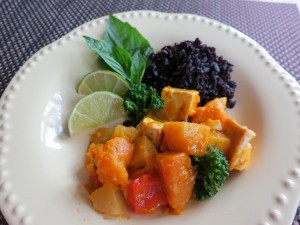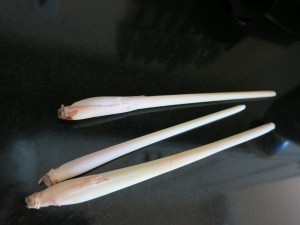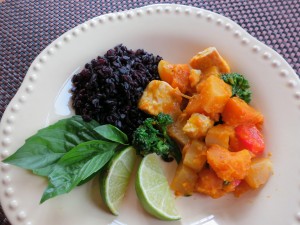Thai Red Curry with Kobacha and Fall Vegetables
Fall weather sends us looking for belly warming meals and this spicy Thai curry with winter vegetables, wrapped up in silky coconut milk sauce, satisfies on many levels. Lemongrass and lime add a fresh citrus zing and Thai basil contributes an herbal note we expect from Thai cooking.
I use browned tofu for protein but you could easily substitute slivers of cooked chicken, pork or beef. It is a meal-in-one served with rice. A hearty black rice is pictured but you could use fragrant brown jasmine rice or another grain.
A variety of nutrient-rich seasonal vegetables absorb the rich curry flavors. Cubes of sweet, dense Kabocha squash, sometimes called Japanese pumpkin, turnips and rutabagas have similar cooking times so can be added at once. Broccolini and sweet bell pepper need less cooking and are added a few minutes later. To save time, use ready-to-cook cut butternut squash, available in many markets, instead of the kabocha.
It is worth seeking out lemongrass,
sometimes called citronella, a woody stalk that grows in tropical climates and used in Southeast Asian cooking. Remove the hard outer layer from the stalk, trim off the root and use the fatter, bottom 3 to 5 inches. For this dish I smash the stalk with a meat pounder to release the flavors, simmer it with the sauce and then remove just before serving.To make this recipe do-able for a weeknight, start with a prepared Thai curry paste. I keep jars of red, green and yellow pastes on hand and once open, store them in the freezer. Thai experts recommend making your own chili pastes – classically pounded together in a large stone mortar and pestle. If you’re the DIY type and have a free afternoon your results will no-doubt be better.
No need to stop at the local Thai restaurant when you can put on your warmest slippers and cook up a Thai dinner at home in no time.
Thai Curry with Kabocha, Winter Vegetables and Tofu
Substitute other vegetables for the ones called for here and adjust cooking time as needed, adding harder and longer-cooking ones first. Choose a variety of colors and textures. If you don’t like tofu, use cooked slivers of chicken, beef or pork. Curry pastes vary in heat and flavor so adjust the amount used to suit your preferences.
Sauce:
1 cup “light” or “lite” coconut milk
1/3 cup water
2 tablespoons packed brown sugar
2 tablespoons fish sauce
2 stalks lemongrass*
2 teaspoons red curry paste, or to taste
1 teaspoon lime zest
1/4 teaspoon salt
Tofu and Vegetables:
1 package (14-ounce) firm tofu, drained and cut into 1-inch cubes
1 tablespoon vegetable oil
3 cups cubed (1-inch) Kabocha squash
1 cup cubed (1-inch) peeled turnip
1 cup cubed (1-inch) peeled rutabaga
1 cup bite-sized pieces of peeled broccolini
1 cup bite-sized pieces red bell pepper,
To Serve:
1/2 cup thinly sliced fresh Thai basil leaves or coarsely chopped cilantro
Cooked rice
Lime wedges
In large deep skillet, combine coconut milk, water, brown sugar, fish sauce, lemon grass, curry paste, lime zest and salt. Whisk to blend. Cover, bring to a boil then reduce heat and simmer gently for 10 minutes. While sauce simmers, heat oil in separate skillet over medium heat; add tofu cubes and sauté, stirring once or twice till brown on all sides. Remove from heat and reserve. Add squash, turnip and rutabaga to curry sauce, re-cover and simmer for 6 to 7 minutes or until vegetables are tender but still hold their shape. Stir in broccolini, bell pepper and browned tofu. Cover and simmer for a minute or two to lightly cook broccolini and heat tofu and bell pepper. To serve, remove and discard lemon grass. Add additional salt or fish sauce, to taste. Stir in basil or cilantro. Pass lime wedges to squeeze over curry. Serve with rice. Makes 4 servings.
*To prepare lemongrass, peel off woody outer layers of each stalk. Cut off bottom 4 or 5 inches of stalk to use in the curry and discard the tops. Trim off root end. Smash stalks with a meat mallet or similar and add to the curry.
© 2013 Lorelle Del Matto



 About lorelle
About lorelle
Would you update these records often cause you really involve some valid points here and would like to hear more from this site.